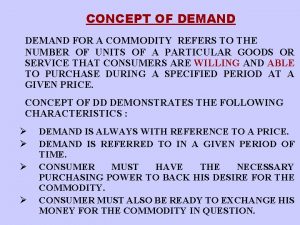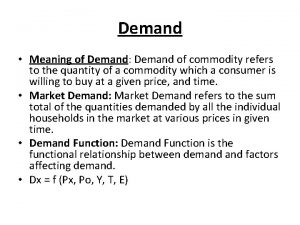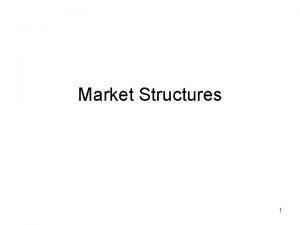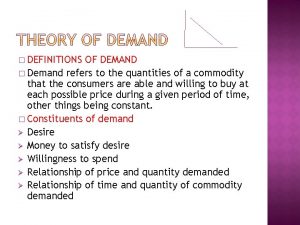MARKET DEMAND Market demand refers to the various












- Slides: 12

MARKET DEMAND Market demand refers to the various quantities per unit of time that buyers are willing and able to buy at all alternative prices, other things being equal.

Market Demand Curves l Assume that there are only two goods (X and Y) and two individuals (1 and 2) • The first person’s demand for X is X 1 = d. X 1(PX, PY, I 1) • The second person’s demand for X is X 2 = d. X 2(PX, PY, I 2)

Market Demand Curves l Features of these demand curves: • Both individuals are assumed to face the • same prices Each buyer is assumed to be a price taker • must accept the prices prevailing in the market • Each person’s demand depends on his or her own income

Market Demand Curves l The total demand for X is the sum of the amounts demanded by the two buyers • The demand function will depend on PX, PY, I 1, and I 2 total X = X 1 + X 2 total X = d. X 1(PX, PY, I 1) + d. X 2(PX, PY, I 2) total X = DX(PX, PY, I 1, I 2)

Market Demand Curves l l To construct the market demand curve, PX is allowed to vary while PY, I 1, and I 2 are held constant If each individual’s demand for X is downward sloping, the market demand curve will also be downward sloping

Market Demand Curves To derive the market demand curve, we sum the quantities demanded at every price PX PX Individual 1’s demand curve Individual 2’s demand curve PX Market demand curve PX* d. X 1* DX d. X 2 X X 2* X X* X 1* + X 2* = X* X

Shifts in the Market Demand Curve l The market demand summarizes the ceteris paribus relationship between X and PX • Changes in PX result in movements along the curve (change in quantity demanded) • Changes in other determinants of the demand for X cause the demand curve to shift to a new position (change in demand)

Shifts in Market Demand l Suppose that individual 1’s demand for oranges is given by X 1 = 10 – 2 PX + 0. 1 I 1 + 0. 5 PY and individual 2’s demand is l X 2 = 17 – PX + 0. 05 I 2 + 0. 5 PY The market demand curve is X = X 1 + X 2 = 27 – 3 PX + 0. 1 I 1 + 0. 05 I 2 + PY

Shifts in Market Demand l To graph the demand curve, we must assume values for PY, I 1, and I 2 l If PY = 4, I 1 = 40, and I 2 = 20, the market demand curve becomes X = 27 – 3 PX + 4 + 1 + 4 = 36 – 3 PX

Shifts in Market Demand l If PY rises to 6, the market demand curve shifts outward to X = 27 – 3 PX + 4 + 1 + 6 = 38 – 3 PX • Note that X and Y are substitutes l If I 1 fell to 30 while I 2 rose to 30, the market demand would shift inward to X = 27 – 3 PX + 3 + 1. 5 + 4 = 35. 5 – 3 PX • Note that X is a normal good for both buyers

Generalizations l Suppose that there are n goods (Xi, i = 1, n) with prices Pi, i = 1, n. l Assume that there are m individuals in the economy l The j th’s demand for the i th good will depend on all prices and on Ij Xij = dij(P 1, …, Pn, Ij)

Generalizations l The market demand function for Xi is the sum of each individual’s demand for that good l The market demand function depends on the prices of all goods and the incomes and preferences of all buyers






















